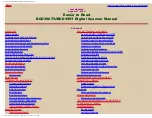
Easier to Read BCD396T/UBCD396T Digital Scanner Manual
Understanding Dynamic Memory
The scanner's memory is organized in an architecture called Dynamic Allocated Channel memory. This type of memory is organized differently and more efficiently than
the bank/channel architecture used by traditional scanners. Dynamic Allocated Design matches how radio systems actually work much more closely and make it easier to
determine how much memory you have used and how much you have left. No memory space is wasted.
Since you can only program one trunking system per bank in a traditional scanner, and let's say you only have 10 banks, you can only store 10 trunking systems. Also,
since some trunked systems might have hundreds of talk groups you wish to monitor, you might have to enter those systems into multiple banks in order to monitor all the
ID's.
Instead of being organized into separate banks and channels, the scanner's memory is contained in a pool. You build the systems and groups then use as much memory
as you need in the pool to store frequencies, talk group ID's, and alpha tags. With all previous scanners, you selected banks to scan that had channels stored in them. With
this scanner, you select 'Systems' to scan that have channel 'Groups' stored within the 'Systems'. Conventional systems have frequency groups and trunking systems have
ID groups. The
trunking
frequencies go into a 'system editor', not a system or a group.
You can store as many as 400 'Systems' and you can have as many as 20 groups per 'System' with up to 200 frequencies or IDs in each 'Group' (if you have enough
memory). The (U)BCD396T will give you up to 6000
tagged
channels.
Understanding Quick Keys
'Quick Keys' are used to turn
systems
and channel
groups
on and off (enable or disable for scanning). They are also used when searching (only) to turn custom and
service searches on and off. This is not the same as locking out or unlocking systems/groups (which you can also do). They are just the number keys on the scanner but
once assigned to systems/groups they
become
the 'Quick Key's. You can program one or more system/group to any quick key or, program one or more system/group with
no quick key (that will
always
be scanned unless you lock it out).
There are 100 'System Quick Keys' (0-99) and 10 and 'Group Quick Keys' (0-9).
My advice is to assign
everything
to quick keys so you don't have to remember what to turn off/on or what to unlock/lockout. There are no indicators in the display showing
systems/groups with
no
quick key so you won't know if they are being scanned unless you see (or don't see) them scroll by in the display.
Conventional Simplex and Repeater Systems
Simplex systems use a single frequency for both transmit and receive. Most radios using this type of operation are limited to line-of-sight operation. This type of radio is
frequently used at construction job sites, and with inexpensive consumer radios such as GMRS/FRS radios. The range is typically 1-8 miles, depending upon the terrain
and many other factors.
Repeater systems use two frequencies: one transmits from the radio to a central repeater; the other transmits from the repeater to other radios in the system. With a
repeater based system, the repeater is located on top of a tall building or on a radio tower that provides great visibility to the area of operation. When a user transmits (on
an input frequency), the signal is picked up by the repeater and retransmitted (on an output frequency). The user's radios always listen for activity on the output frequency
and transmit on the input frequency. Since the repeater is located very high, there is a very large line of sight. Typical repeater systems provide coverage out to about a 25-
mile radius from the repeater location.
Understanding CTCSS/DCS
http://marksscanners.com/396/396.shtml (5 of 51)8/17/2010 10:11:39 PM






































